ChatGPT has many powerful functions, and accurate context translation is one of them.
Although ChatGPT was not built specifically for translation, ChatGPT is quickly becoming a reliable translation tool. ChatGPT is trained on large text corpora in dozens of languages and deployed on a conversational interface, providing unparalleled flexibility in translation far beyond what traditional translation tools can provide.
However, to get the most out of ChatGPT as a translation tool, you need to do some homework on Prompts. We've done the hard part - here's how to get the best results with ChatGPT as a translation tool.
01
—
Why use ChatGPT for translation?
Google Translate, Microsoft Translate and DeepL are the most popular translation tools on the internet. There are dozens more, all offering impressive accuracy, free access, and covering dozens of languages. So why choose ChatGPT? What makes ChatGPT a good translation tool?
Well, unlike almost all popular translation tools, ChatGPT's interactivity makes it a great translation tool. Use other translation tools: provide text -> get translation, that's all. It doesn't matter if it's the best translation you can get.
Using ChatGPT, you can customize translations to meet specific needs and provide feedback on adjustments you would like to see. For example, tone and style can be adjusted, and some cultural connotations and regional differences in word meanings can be taken into account, which is not possible with dedicated translation tools such as Google Translate.
If you're wondering how ChatGPT stacks up against Google Translate as a translation tool, here's how ChatGPT compares to Google Translate.
02
—
How to translate with ChatGPT
Translating with ChatGPT is easy. All you need to do is provide the text to translate, specify the language to translate, and ChatGPT will take care of the rest.
1. Provide context
One of ChatGPT's main advantages over popular translation tools like Google Translate is its ability to accurately consider the context of the text when generating translations. Considering context can be the difference between simply translating individual words in a sentence and generating translations that truly reflect the author's or speaker's intent.
Take the Spanish sentence "Gracias por preguntar, pero estoy bastante seguro aquí" for example. Google Translate yields "Thanks for asking, but I'm pretty sure here" as a translation. While that's not entirely wrong, depending on the context, this sentence could mean, " Thanks for asking, but I'm safe here ."

Of course, Google Translate will provide the same translation no matter how many times you try to translate it, because it cannot recognize contextual nuances. According to the screenshot above, ChatGPT will try to provide the most accurate translation based on the context provided. Providing context can significantly improve translation quality. If you're not sure how to provide context, here's some inspiration:
-
"Translating [the Filipino translated text] into English from the perspective of a native Filipino speaker" should try to keep as much cultural connotation in the translation as possible.
-
"Translate [the text to be translated] into English from the perspective of someone discussing the COVID-19 pandemic" should use appropriate medical terms rather than generic words.
-
"Translate [text to be translated] into English. Text discusses a battle during World War II" Appropriate military and historical terminology should be used
-
2. Declare text type
Another important factor that can improve translation accuracy is the direct declaration of the type of text to be translated. For example, is it an idiom, song, financial document, or plain text? Simply letting ChatGPT know what to translate gives the chatbot an advantage in providing more accurate translations.
Instead of simply using a prompt like "Translate [text to translate] into [target language]". Ideally, the following alternatives should be used:
-
Translate bracketed [financial reports | poems | songs | Bible parts | proverbs] into [target language]
-
Translate [text to translate] into [target language]. The text to be translated is [military report | medical document | drug prescription]
Original text in English:
The prompts above or similar ones help ChatGPT use relevant or industry-specific context when generating a translation. Although ChatGPT sometimes recognizes the right niche words to use for translation, you'll have to explicitly prompt it to do so using type declaration in some cases.
The tips above, or similar ones, can help ChatGPT use relevant or industry-specific context when generating translations. While ChatGPT will sometimes identify the correct jargon for translation, in some cases it must be explicitly prompted to do so using a type declaration.

3. Use style transfer
Sometimes, when translating text, the translation may be too technical or simply not suitable for the intended audience. Using style transfer in ChatGPT can help adjust the tone and style of translations to match the target audience or industry. So, if you're translating legal documents, the translation can preserve the author's original meaning while using more layman's wording. In the example below, I translate football commentary from English to Chinese, first without style transfer and then with style transfer.
Look at Google Translate first:
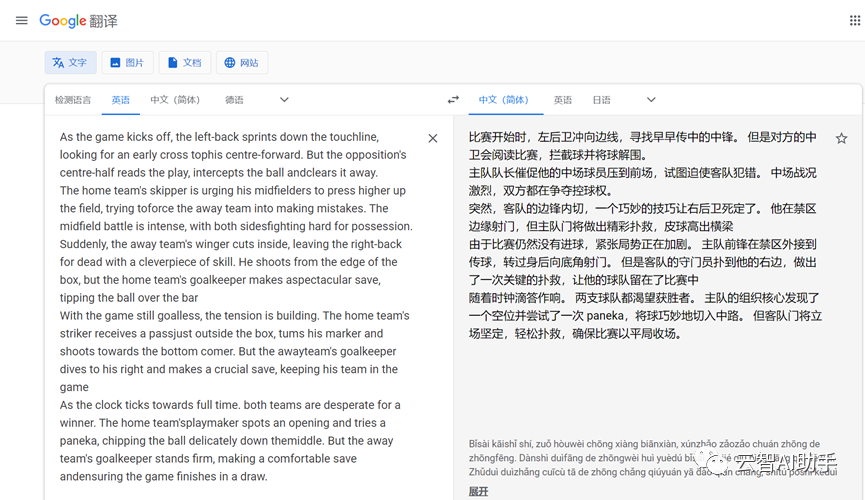
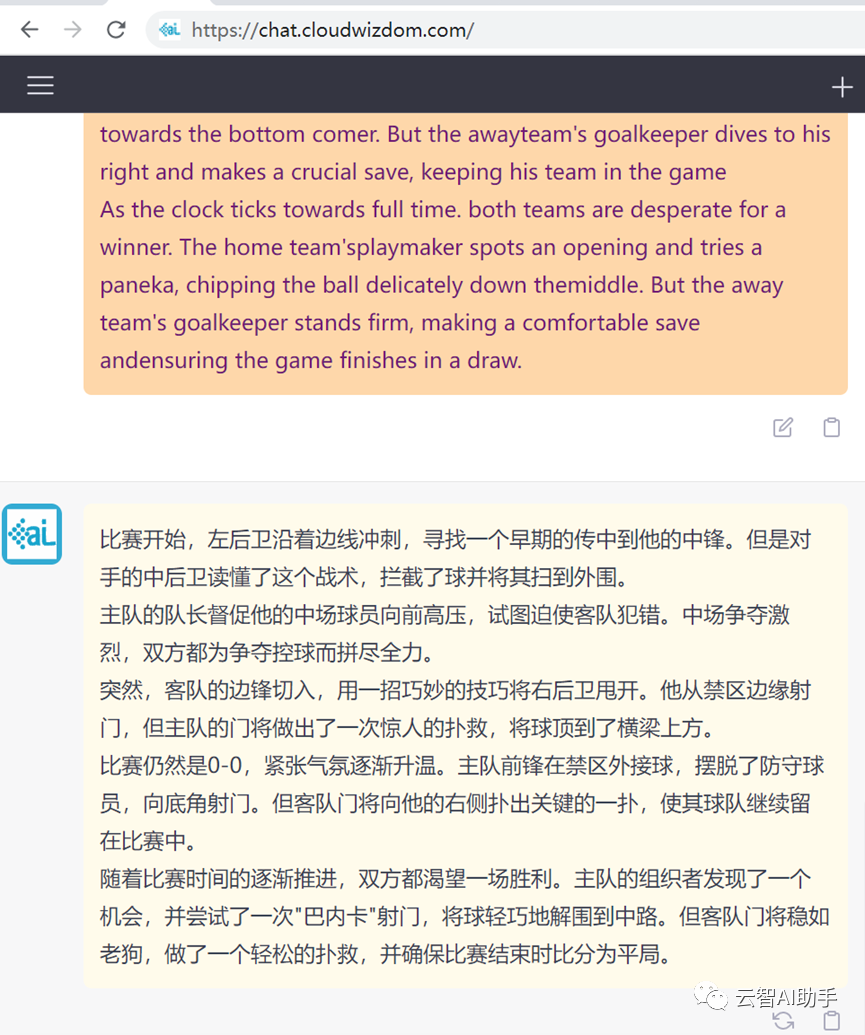
The upper translation uses the closest Chinese counterpart to the corresponding English word, while the lower translation uses words suitable for audiences unfamiliar with football terminology. Interestingly, however, both translations are believed to be accurate.
Prompt words below: Please use the tone of football commentary to translate

To use style transfer while translating, use the following tips:
-
Translate [text to be translated] into [target language] in colloquial terms.
-
Translate [text to translate] into [target language] for [grade 5] audience
-
Translate [text to translate] into [target language]. Use style transfer to adapt translated text to [target audience]
4. Consider regional differences
Some words may have different meanings or connotations depending on the region or country of the speaker. For example, the English sentence "I want to play football" can be translated into Chinese "I want to play football (Wǒ yào qù tī zúqiú)". While this seems like a perfect translation, the translation may be wrong if the speaker is American. By saying "soccer," the American speaker may be referring to the rugby-style sport known as American football, rather than football as it is known in other parts of the world.
Conventional translation tools cannot account for this potential misunderstanding. ChatGPT, on the other hand, can provide different translations depending on the origin of the speaker.
We enabled ChatGPT to translate "I want to play football" into Chinese. As expected, it yields "I'm going to play football (Wǒ yào qù tī zúqiú)". In Chinese, "zúqiú" means "soccer," referring to soccer rather than rugby-style sports.
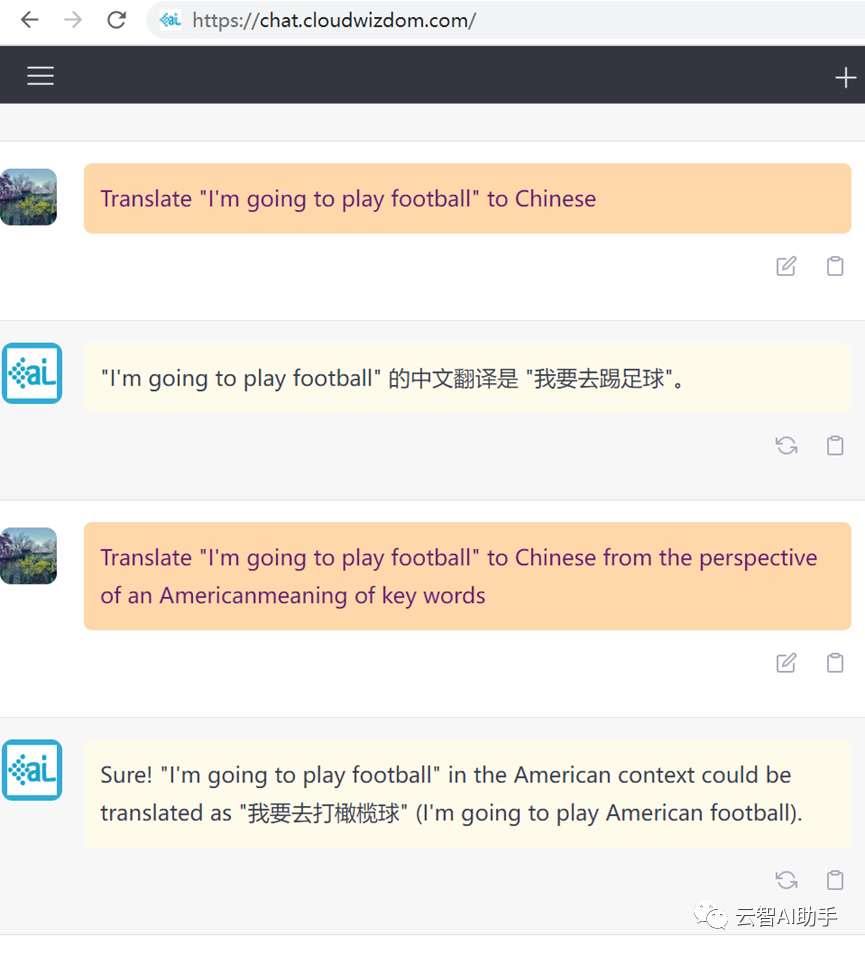
We repeated the translation prompts but added hints about the speaker's origin and possible intent. ChatGPT changed the translation to "I'm going to play football (Wǒ yào qù tī gǎnlǎnqiú)", this time using "gǎnlǎnqiú", which is the Chinese term for American football, to better reflect the speaker's underlying intent.
5. Use summary translation
Sometimes, you don't want to read the entire text, you just want to understand what the author or speaker is trying to convey. ChatGPT is one of the few tools that provides reliable translations for such situations. To get a summary translation, ask ChatGPT for a "summary" or "condensed" translation of the target text. Some example prompts include:
-
Provide a descriptive but concise translation [text to be translated] in Spanish.
-
Provide a summary translation of [text to be translated] in French.
-
Provide an abstract translation of [text to be translated], in English.
-
Translate this article into Dutch, but only include key points.
6. Use a fine-tuned instance of ChatGPT
Using a fine-tuned instance of ChatGPT is one of the best ways to utilize ChatGPT as a translation tool. It opens up almost limitless possibilities for translation with AI chatbots. But how to adjust ChatGPT for translation?
You can do this in several ways. A key component of tuning ChatGPT for translation is stipulating the rules the chatbot must follow when translating any text it is provided. For example, you can adapt ChatGPT by providing word-translation pairs or text-translation pairs. Here is an example:
Trying to convert a piece of Pidgin text (Note: Pidgin is a mixed language, usually a mixture of two different languages. This language is usually used as a communication tool for simple communication between different languages.) When translating into English, we encountered some mistranslated words. Providing the following word-translation pairs causes ChatGPT to update the translations of these words in subsequent translations.

You can also make ChatGPT translations more accurate by providing several large texts with their verified translations. You can then prompt ChatGPT to infer the correct translation of words and phrases from the provided examples and apply it when translating text involving similar language pairs. While it is possible to fine-tune ChatGPT translations with significantly longer text, the following are brief instructions for using short paragraphs.
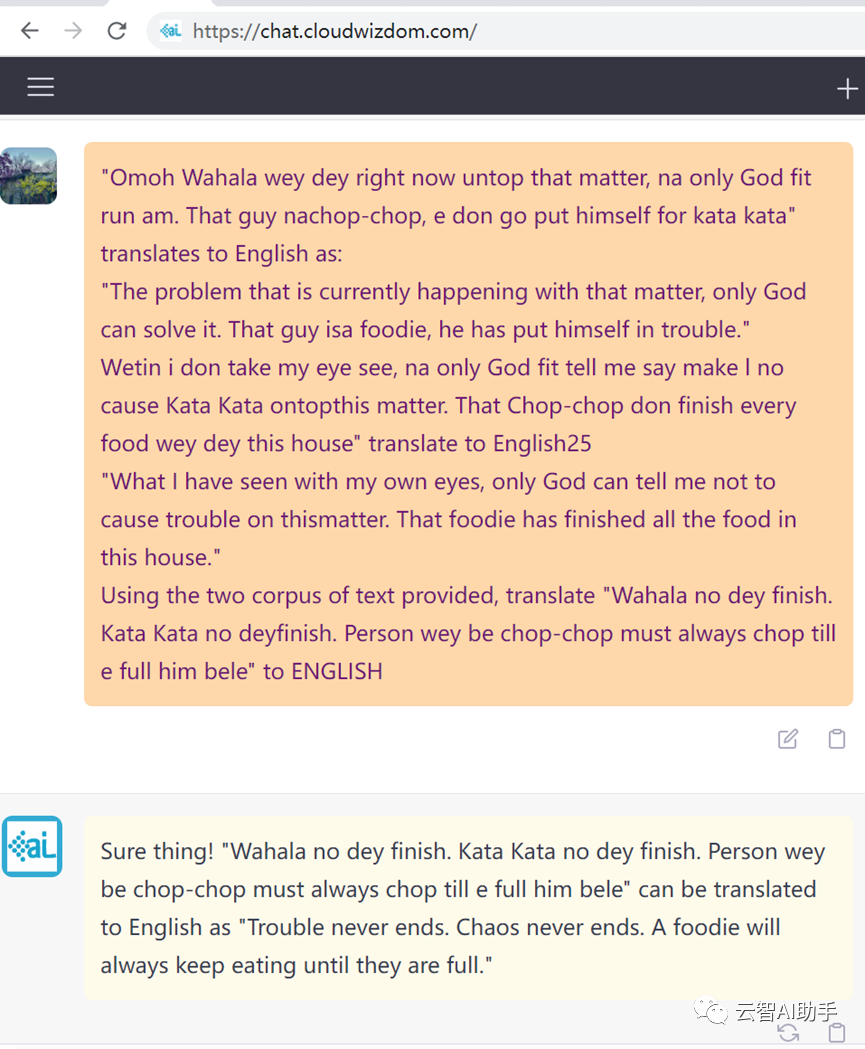
translate to Chinese:
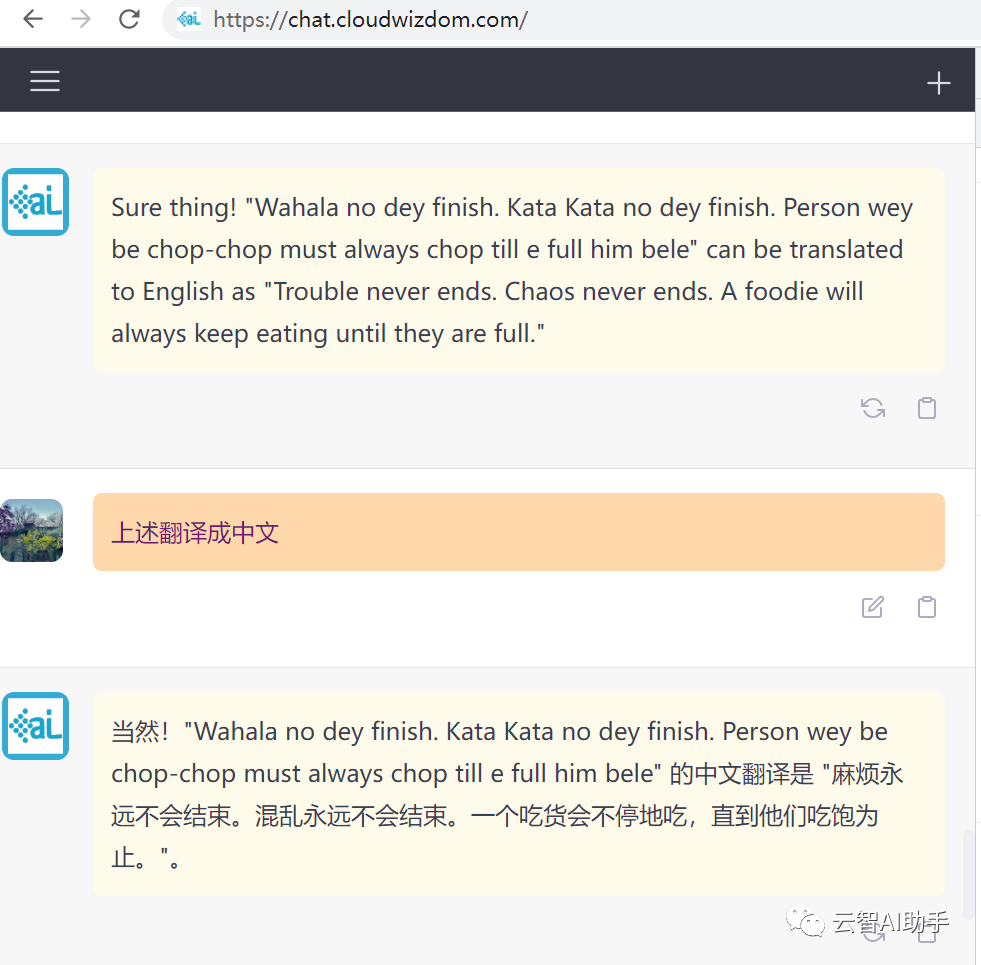
We achieved improved translations every time it was prompted without taking any further steps.
7. Translation of abstracts
Put the graduation thesis at the front, and the most important part must be the abstract. Wouldn't it be a pity if our abstract was well written in Chinese, but the English translation of the abstract failed. Most of our graduates' own translation skills should be lower than those of Baidu Translate and Google Translate, for example, and their translations are always many times better than their own translations. Someone went to a certain treasure to find a professional translator to translate. Although the other party's English level is very high, but you are not familiar with the technical terms, the translation is very unsatisfactory. Through the summary of the above 6 points, let's see how ChatGPT translates?
We randomly find a translation of the last paragraph of the abstract of a paper in a professional field:
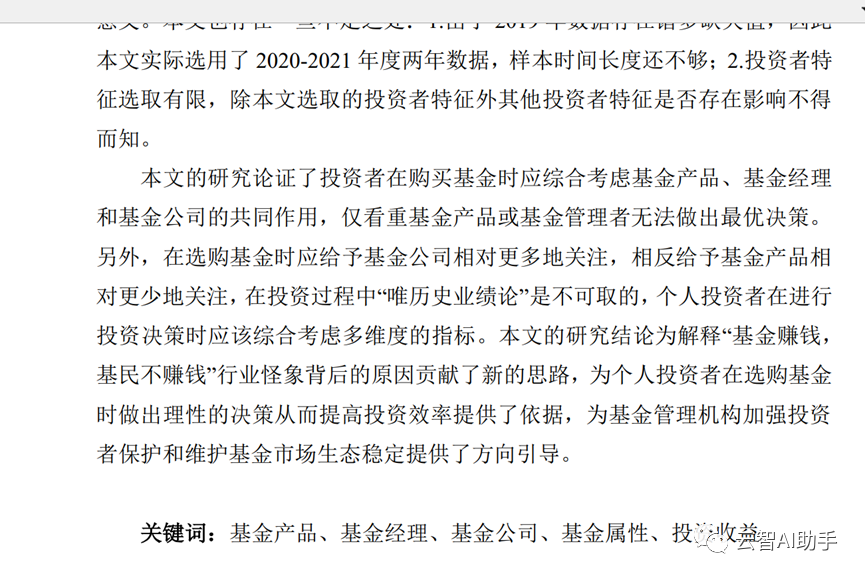
Chinese and English abstract translation of the paper:
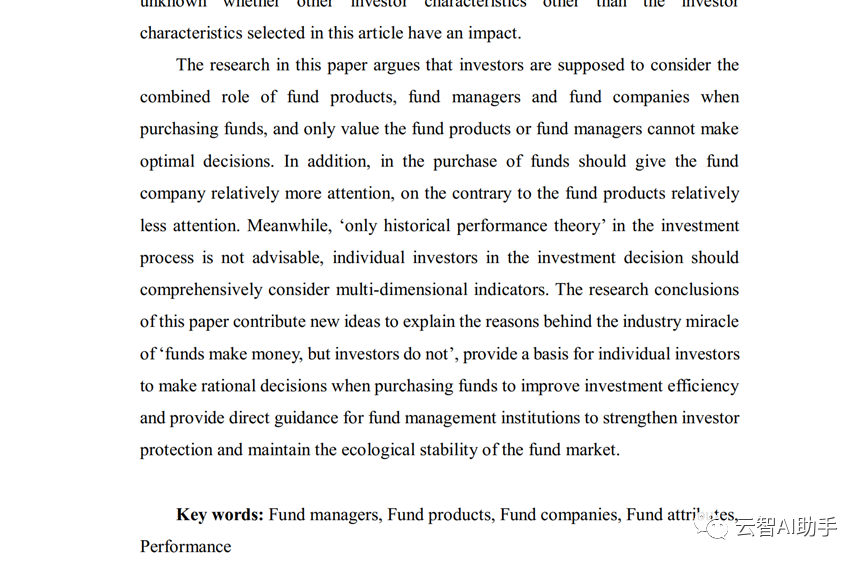
The qualifier I used is "The following is part of the abstract of fund investment-related papers, please translate into English." Let's take a look at the ChatGPT translation results:

The pros and cons of the two translations can be compared by the judges themselves, then let’s take the English version translated by the author and ask ChatGPT if there is anything that needs to be improved:

How do you feel about the assignments corrected by this professional English tutor? Can you make your abstract more professional?
| Product Experience |

The above screenshots are all from our AI assistant: Do you know AI Q&A? If you are interested, you can click the link to view it. You can log in directly by scanning the QR code on WeChat. No other complicated verification is required. New users can try it for free for 3 days.
Click the original text to experience it directly or press and hold the QR code in the picture to experience it!

| Recommended reading |
1. How to make a weight loss plan efficiently
2. How to quickly generate a copy
3. How to successfully complete the graduation thesis
4. How to become an invincible programmer in the universe
5. Quick Cheats for Essays Helped by ChatGPT
6. My mother gave birth to me, and ChatGPT eliminated my father